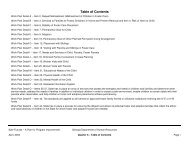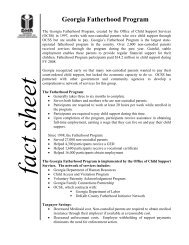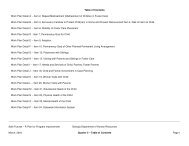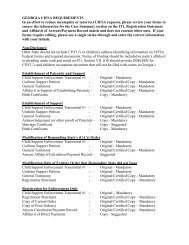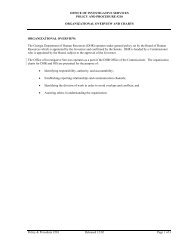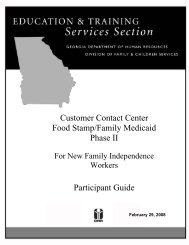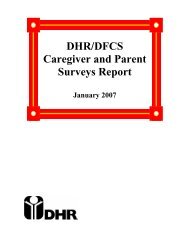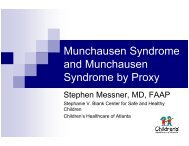an overview georgia program improvement plan - Department of ...
an overview georgia program improvement plan - Department of ...
an overview georgia program improvement plan - Department of ...
You also want an ePaper? Increase the reach of your titles
YUMPU automatically turns print PDFs into web optimized ePapers that Google loves.
5 th Quarter DOCUMENTATION: The Supreme Court <strong>of</strong> Georgia, Administrative Office <strong>of</strong> the Courts, Child Placement Project,<br />
Model Courts Project, DRAFT, Summer Assessment Review 2003 - A Snapshot <strong>of</strong> Juvenile Court Perform<strong>an</strong>ce in Child Deprivation<br />
Cases <strong>an</strong>d Recommendations for Continued Improvement, February 2004<br />
6 th Quarter Report: Achieved. See 5 th Quarter response concerning the <strong>an</strong>alysis <strong>of</strong> the data indicating that the frequency <strong>of</strong> reviews<br />
does not necessarily appear to increase time to perm<strong>an</strong>ency. Individual case nu<strong>an</strong>ces may require more frequent review. However,<br />
the current st<strong>an</strong>dard <strong>of</strong> review continues, with policy encouraging more frequent reviews as needed.<br />
6 th Quarter DOCUMENTATION: .http://www.state.ga.us/courts/supreme/cpphttp://www.state.ga.us/courts/supreme/cpp/<br />
6 th Quarter Federal Response: D7: Need to review documentation (CIP Report) provided which the State uses to assess step as<br />
achieved. The report from the Office <strong>of</strong> the Child Advocate referenced as documentation is 2 years old <strong>an</strong>d is a scathing report on<br />
DFCS.<br />
7 th Quarter Report: The State has evaluated a sample <strong>of</strong> court case files <strong>an</strong>nually to see if more frequent hearings lead to faster<br />
perm<strong>an</strong>ency. It was the conclusion reached that more frequent hearings did not necessarily lead to expedited perm<strong>an</strong>ency. As stated<br />
earlier, the “activist state <strong>of</strong> the local DFCS <strong>an</strong>d the local court, coupled with the size <strong>of</strong> the caseload, impacted the swiftness at which<br />
perm<strong>an</strong>ency was achieved. With this conclusion reached, the State will not amend its review periodicity, which is within 90 days <strong>of</strong><br />
the entering <strong>of</strong> the dispositional order incorporating the 30-day case pl<strong>an</strong> (but no later th<strong>an</strong> 6 months following removal), <strong>an</strong>d then at<br />
least every six months thereafter. The Office <strong>of</strong> the Child Advocate Report reference in the 5 th reporting quarter may have been a<br />
"scathing" report on DFCS. As for this Action Step, the reference in the 5 th report was at end <strong>of</strong> the Office <strong>of</strong> the Child Advocate's<br />
<strong>an</strong>nual report, entitled 'Time from Removal to Finalized Adoption' <strong>an</strong>d 'Time from Removal to Reunification'.<br />
8 th Quarter Report: Achieved. The CFSR addressed the percent <strong>of</strong> children achieving timely perm<strong>an</strong>ency <strong>an</strong>d found that percentage to be<br />
71.4%. For Georgia to document <strong>improvement</strong>, ACF agreed (7 th quarter) to allow the state to amend the benchmark for evaluating this action<br />
step to the <strong>an</strong>nual report produced by the Office <strong>of</strong> Child Advocate. The Office <strong>of</strong> Child Advocate Report, (reference Appendix G) referred<br />
to in Quarter 5 provides a baseline measure to address the achievement <strong>of</strong> timely perm<strong>an</strong>ency under the current system <strong>of</strong> review. From April<br />
2000 through March 2002, 77% <strong>of</strong> children removed from their homes were reunified within 12 months. The national st<strong>an</strong>dard is 76%. More<br />
recent data from the state's Key Perform<strong>an</strong>ce Indicators (KPI), rates the achievement <strong>of</strong> perm<strong>an</strong>ency for children reunified within 12 months.<br />
The KPI percentage rates <strong>of</strong> timely reunification during the period September 2003 - August 2004 r<strong>an</strong>ges from 74% to as high as 84.97%.<br />
The average rate is 78.61%. Based on the review <strong>of</strong> findings from the OCA Report it was concluded that more frequent reviews did not<br />
necessarily lead to expedited perm<strong>an</strong>ency.<br />
8 th Quarter DOCUMENTATION:<br />
(1) Appendix G <strong>of</strong> the Office <strong>of</strong> Child Advocate Annual Report "Time from Removal to Reunification with Parent, Caretaker or Relative<br />
April 2000 through March 2002".<br />
Safe Futures – A Pl<strong>an</strong> for Program Improvement<br />
Georgia <strong>Department</strong> <strong>of</strong> Hum<strong>an</strong> Resources<br />
November, 2004 Quarter 8 - Work Pl<strong>an</strong> D Page 13




